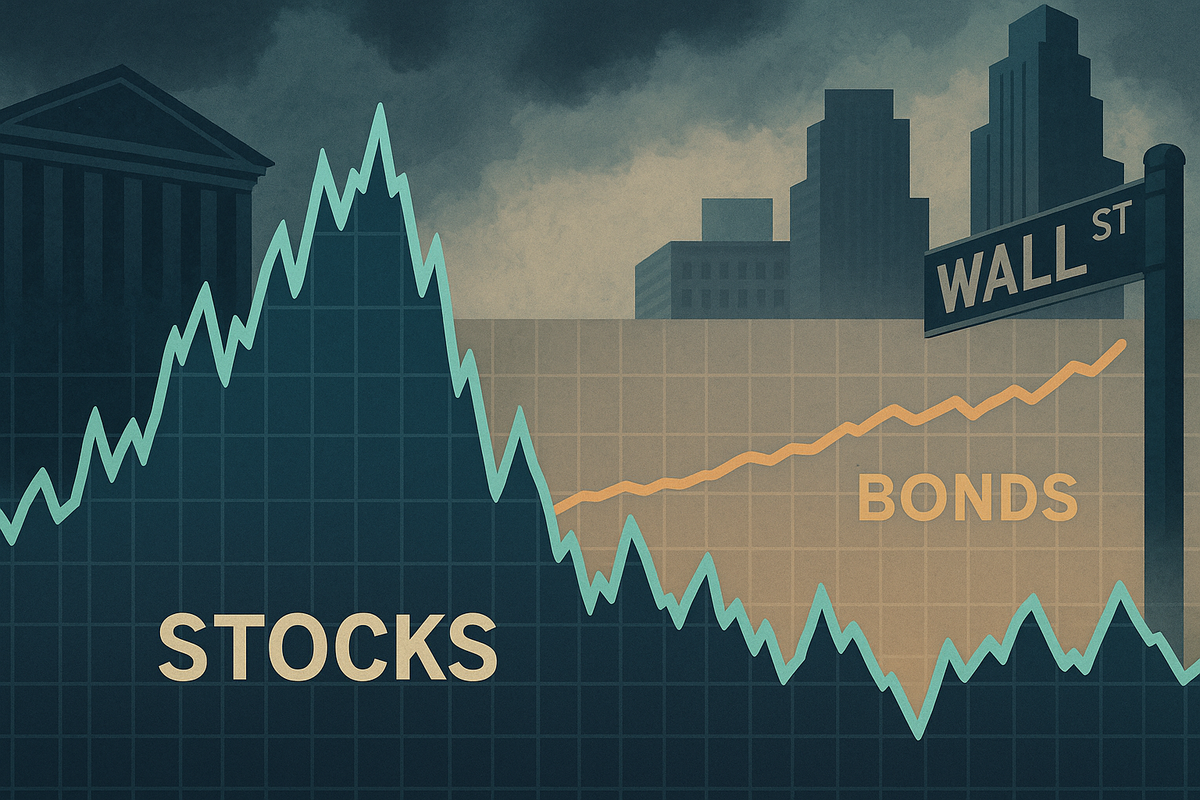
Wall Street is currently grappling with a pervasive "risk-off" sentiment, a mood characterized by a cautious retreat from higher-risk assets. This prevailing sentiment is particularly evident in the tech sector, which has experienced a significant sell-off, yet it presents a puzzling disconnect with the broader stock market's surprising resilience. Meanwhile, longer-duration Treasury yields remain stubbornly elevated, fueled by persistent concerns over government deficits. This divergence in market signals, coupled with a fascinating shift in perception where retail investors are increasingly seen as "smart money" while institutional players adopt a defensive stance, paints a complex and intriguing picture of the current financial landscape.
This article will delve into the intricacies of this "risk-off" environment, exploring the factors driving the tech sector's downturn, the perplexing chasm between stock and bond market sentiment, and the evolving roles of retail and institutional investors. Understanding these dynamics is crucial for navigating the current market volatility and anticipating future trends.
The Tech Sector's Retreat and the Bond Market's Warning
The current "risk-off" mood on Wall Street is largely influenced by a significant sell-off in the technology sector, particularly impacting the "Magnificent Seven" tech giants. This correction, which saw a dramatic rotation out of high-growth technology stocks and into more defensive sectors during Q2 2025, was triggered by a confluence of factors. A hotter-than-expected U.S. Producer Price Index (PPI) report in July 2024 dampened hopes for near-term interest rate cuts, exacerbating investor caution. Geopolitical risks, including the imposition of tariffs on various countries, further amplified market uncertainty.
A key catalyst for the tech downturn was the "collapse of the AI trade," which had been a dominant theme in 2024. Companies like NVIDIA (NASDAQ: NVDA) and AMD (NASDAQ: AMD) saw sharp declines as investors took profits amid mixed economic signals. The VanEck Semiconductor ETF (NYSEARCA: SMH) fell 12% in Q2 2025, highlighting the sector's sensitivity to interest rates and global trade dynamics. Skepticism regarding the sustainability of the AI frenzy, fueled by a July 2025 MIT report indicating limited measurable business returns from generative AI investments, triggered a notable downturn across the tech sector. The "Magnificent Seven" tech companies collectively shed a staggering $2.4 trillion in market value since the start of 2025, with Tesla (NASDAQ: TSLA), Nvidia (NASDAQ: NVDA), Apple (NASDAQ: AAPL), and Alphabet (NASDAQ: GOOGL) experiencing significant plunges. This sell-off is largely attributed to stretched valuations, recession fears, and rising volatility, prompting investors to re-evaluate their exposure to high-growth stocks. Despite the sharp correction, some analysts view this period as a "healthy reset" for the AI sector, rather than an end to its growth.
Adding to the complexity is a notable disconnect between the stock and bond markets, with each signaling different economic outlooks. The stock market, particularly the S&P 500, has shown surprising resilience and projects optimism, with higher equity prices and earnings growth, even nearing record highs. In contrast, the bond market signals weakening growth and is pricing in Federal Reserve rate cuts, anticipating an economic slowdown. Longer-duration Treasury yields remain elevated due to concerns over deficits and the need for government refunding. This situation presents a puzzle, as the bond market is often considered the "adult in the room" on Wall Street, providing a more robust signal about the economy's direction due to its lesser susceptibility to retail or meme-driven forces. Apollo chief economist Torsten Slok highlighted this divergence, suggesting that either equity analysts are overly optimistic or economists are too pessimistic. Despite investors significantly paring back expectations for Fed rate cuts, the S&P 500 has continued to rise, indicating that solid growth and an ongoing earnings recovery are currently outweighing the challenges posed by higher interest rates.
The Shifting Sands: Retail "Smart Money" and Institutional Caution
In a fascinating reversal of traditional roles, retail investors are increasingly perceived as a driving force behind the current U.S. stock market rally, challenging the long-held notion of institutional investors as the sole "smart money." Retail participation in the total fund flows of the S&P 500 Index reached 12.63% recently, marking the highest proportion since February. Barclays equity strategists identify retail investors as the "primary" driver of the current rally, having collectively invested over $50 billion in global equities in the past month. This enthusiasm from retail traders contrasts sharply with a "lackluster" institutional participation. Indeed, retail traders have reportedly outperformed institutional players since April.
However, this perception comes with caveats. Some analysts suggest that when hedge funds (often referred to as "smart money") short stocks while retail investors go long, the stock market typically underperforms in the subsequent one to three months. Currently, "smart money" is exhibiting a clear lack of interest in stocks and is quietly exiting the market as retail investors display increasing "greed." Retail investors disproportionately own shares in the "Magnificent Seven" tech companies, holding 30% of these shares compared to 18% for other S&P 500 companies held by intrinsic investors. Historically, a surge in share prices driven by retail investors has sometimes indicated a market bubble.
In stark contrast to the bullish retail sentiment, many institutional investors are adopting a decidedly defensive stance. They are actively hedging against market volatility, reallocating their portfolios, and reducing their exposure to risk. Institutional investors have been consistent sellers of U.S. stocks throughout 2025. Hedge funds, in particular, have significantly cut their equity exposure, with one report indicating a nearly $45 billion reduction over a 30-day period, marking a sharp divergence from retail buying. Goldman Sachs (NYSE: GS) reported that hedge funds executed their largest single-week stock selling volume since 2010. Institutional fund managers largely view U.S. stocks as overvalued and are preparing for potential volatility, evidenced by a notable increase in put option activity on tech-heavy indices. While some institutional investors expressed guarded optimism for 2025, with a split between favoring growth sectors like Information Technology and defensive sectors such as Healthcare and Utilities, the overall trend points to caution. In Q1 2025, defensive sectors like utilities, healthcare, and energy were the primary drivers of stability in the U.S. equity market, with value stocks outperforming growth peers. Investment firms like Invesco (NYSE: IVZ) are maintaining defensive portfolio positioning, favoring fixed income over equities, and underweighting credit risk.
Industry Impact and Broader Implications
The current "risk-off" mood and the tech sector sell-off have significant implications across various industries. The tech industry, particularly companies heavily reliant on AI and high-growth narratives, will likely face continued scrutiny regarding their valuations and the tangible returns on their investments. This period could force a more disciplined approach to capital allocation and a greater emphasis on profitability over pure growth. Companies that can demonstrate clear pathways to monetization and sustainable business models will be better positioned to weather the storm. The broader market could see a rotation towards more established, value-oriented companies and defensive sectors, as investors seek stability amidst uncertainty.
The divergence between stock and bond market sentiment also poses a challenge for policymakers. The Federal Reserve, in particular, will need to carefully navigate its monetary policy decisions, balancing the stock market's resilience with the bond market's signals of weakening growth. Any misstep could exacerbate market volatility. Historically, such disconnects have often preceded periods of increased market turbulence or economic shifts. The current environment echoes past periods where investor sentiment became detached from underlying economic realities, sometimes leading to sharp corrections. Regulatory bodies may also increase their scrutiny of the tech sector, particularly concerning market concentration and potential anti-competitive practices, which could further impact the "Magnificent Seven" and other dominant players.
What Comes Next
In the short term, the "risk-off" sentiment is likely to persist, particularly if economic data remains mixed or if geopolitical tensions escalate. The tech sector may continue to experience volatility as investors re-evaluate valuations and the long-term prospects of AI-driven growth. We could see further rotation into defensive sectors and a continued preference for fixed income among institutional investors. The bond market's elevated yields will likely remain a key indicator of underlying economic concerns, and any significant shift in Treasury yields could signal a change in the broader market outlook.
In the long term, this period could lead to a healthier rebalancing of the market. The tech sector, after its "healthy reset," may emerge stronger, with a greater focus on sustainable innovation and profitability. Companies that adapt to the new environment by diversifying their revenue streams and demonstrating robust fundamentals will be better positioned for future growth. The evolving role of retail investors will also be a crucial factor to watch. If retail investors continue to drive market rallies, it could lead to new market dynamics and potentially challenge traditional investment strategies. Conversely, a sustained period of underperformance by retail-driven stocks could lead to a retreat of individual investors from the market. Strategic pivots will be essential for both companies and investors. Companies may need to prioritize cost efficiency and resilience, while investors may need to adopt more diversified portfolios and a more cautious approach to high-growth assets.
Conclusion
Wall Street's current "risk-off" mood, characterized by a tech sector sell-off and a perplexing disconnect between stock and bond market sentiment, presents a complex and challenging environment for investors. The shift in perception, where retail investors are increasingly seen as "smart money" while institutional players adopt a defensive stance, adds another layer of intrigue to the market dynamics.
Key takeaways from this period include the importance of fundamental analysis over speculative trends, the need for diversification across asset classes and sectors, and the critical role of macroeconomic indicators in shaping market sentiment. Moving forward, investors should closely watch for shifts in Federal Reserve policy, further economic data releases, and any changes in geopolitical tensions. The resilience of the broader stock market in the face of elevated bond yields will be a key indicator of underlying economic strength or potential overvaluation. Ultimately, this period of "risk-off" sentiment and market divergence could serve as a crucial test of market fundamentals and investor discipline, shaping the financial landscape for months and years to come.





